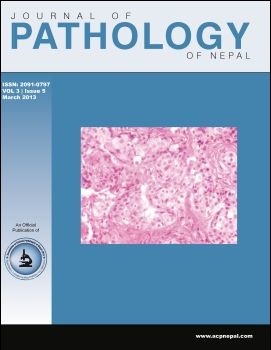Immunophenotypic study of acute leukemia by flow cytometry at BPKMCH.
DOI:
https://doi.org/10.3126/jpn.v3i5.7856Keywords:
Acute leukemia, Flow cytometry, ImmunophenotypeAbstract
Background: Immunophenotyping of acute leukemia is one of the most important clinical applications of fl ow cytometry. The aim of this study was to determine the immunophenotyping profi le of acute leukemia, by means of a fl ow cytometric method, using monoclonal antibodies all marked with a fl uorochrome, in four colour systems to assess their distribution according to type of leukemia (lymphoid B or T / myeloid).
Materials and Methods: We retrospectively collected data of immunophenotyping from 52 acute leukemia patients at the department of pathology in B.P. Koirala Memorial Cancer Hospital from January 2010 to December 2011. Diagnosis was based on peripheral blood and bone marrow examination for morphology, cytochemistry and immunophenotypic studies.
Results: Out of total 52 cases of acute leukemia diagnosed by fl ow cytometry over a two year period, there were 31 cases (59.6 %) of acute lymphoblastic leukemia, 20 cases (38.4 %) of acute myelogenous leukemia and one case (1.9 %) of bi-phenotypic acute leukemia. Leukemia was diagnosed among adults in 44.2 % whereas among children with age less than or equal to 15 years in 55.7 %. Thirty eight (73%) were male and 14 (27 %) were female with a male: female ratio of 2.7:1. For acute myelogenous leukemia, it was found that M0 (5.0 %), M1 (20%), M2 (60%), M3 (15%), M4 (5.0 %) were detected. CD13 and CD33 were the most useful markers in the diagnosis of acute myelogenous leukemia. The most common subtype was AML-M2. Of the 31 cases with acute lymphoblastic leukemia, 20 cases (64.5 %) were identifi ed as B-ALL and 11 cases (35.5%) as T-ALL. Aside from cytoplasmic CD3 (cCD3) and CD7 were the most sensitive antigens present in all cases of T-ALL. All cases of B-ALL showed expression of pan B-cell markers CD19 and CD22, but 15 (75 %) of 20 cases expressed CD10.
Conclusion: Flow cytometric immunophenotyping was found to be especially useful in the correct identifi cation and diagnosis of acute myeloid or lymphoblastic leukemia and its subtypes. In combination with French-American-British (FAB) morphology and immunophenotyping, we were able to diagnose and classify all patients with acute leukemia in this study.
Journal of Pathology of Nepal (2013) Vol. 3, No.1, Issue 5, 345-350
Downloads
Downloads
Published
How to Cite
Issue
Section
License
This license enables reusers to distribute, remix, adapt, and build upon the material in any medium or format, so long as attribution is given to the creator. The license allows for commercial use.




